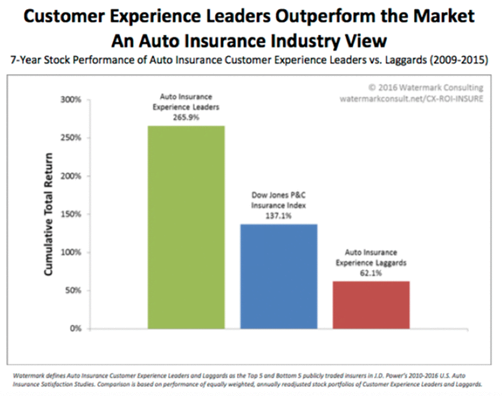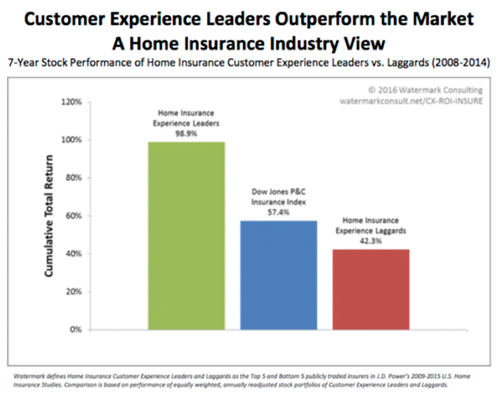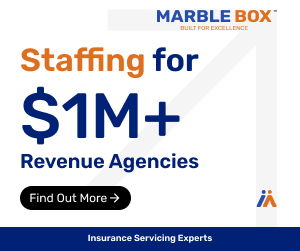
Insurance businesses in the homeowners’ segment with good customer service scores also outperformed laggards by huge margins:

Images: Watermark Consulting
The Watermark study isn’t an outlier. Another recent survey from McKinsey & Company likewise found that the most profitable auto insurance companies and the ones generating the most shareholder value are consistently the very same ones that are offering the best customer engagement experiences.
It’s not even close. The McKinsey study found that those companies that consistently delivered best-in-class customer experiences generated 100 to 300 percent more new business growth, and about 30 percent higher profitability than firms that had an inconsistent customer experience.[1]
Why? In part, because customers with high satisfaction ratings are 80 percent more likely to renew their insurance policies than those that were not happy with their experiences interacting with the company.
McKinsey found, unsurprisingly, that companies with high customer satisfaction ratings posted higher revenues, had better customer retention, less price sensitivity, greater wallet share and positive word of mouth. They experienced better success rates for cross-selling activity, so not only did customers stay with the company longer – they generated more premium.
They also experienced lower expenses, thanks to lower costs of customer acquisition, fewer complaints, and the simple fact that happy customers are actually much less time-consuming than unhappy ones – and naturally more willing to recommend your company to their friends and families.
“Today the consequences of subpar service are amplified by the speed and reach of social media,” warned McKinsey’s analysts.
What to do
Looking to make some improvements? Here are some of the best practices from around the industry:
- Make customer service a quality part of your brand. Yes, it costs money to invest in good technology and excellent customer service personnel. But being forced to compete on price alone because your customer retention is bad and you don’t get word-of-mouth referrals from happy customers costs much, much more.
- Elevate quality customer service responsibility to the CEO and Board level. Managers must place leadership emphasis on the importance of a quality customer engagement on every call.
- Embrace the phone. Yes, the tendency in recent years has been to attempt to automate everything. But according to research from Frost & Sullivan, customers still overwhelmingly try to reach a live agent, and are much more satisfied with their experiences after engaging with a real live human being than they are after entirely automated engagements.
- Remain open to feedback. Regular phone contact is an important part of your information feedback loop. Without it, you are flying blind. Customers will tell a live agent how they feel about your company over the phone. They cannot tell you using a fully automated process. At best you’ll rely on emailed comments the vast majority of them will never send.
- Find ways to exceed expectations with every customer contact. Because actual contact with customers in the insurance business is so rare, each contact that does occur is extremely important. In many cases, it will be the customer’s only direct interaction with the company.
- Settle claims fast.
- Make communication possible across a variety of platforms. Think phone, SMS, smartphone, apps, your website, email, snail mail, and even Twitter and other social media sites.
- Invest in training. Customer service knowledge and professionalism was a key component of customer satisfaction.
- Talk with customers. Find out ‘pain points’ and ‘wow moments’, and deploy resources and energy to minimizing the first and maximizing the latter.
- Wait times are important, but they aren’t everything. One large auto carrier found that customers were much more interested in having a consistent point of contact for everything related to their claim or issue than in having a short hold time on the phone.
If it’s bad, he or she will likely go elsewhere. Indeed, you may have created a brand ambassador – for somebody else!
Looking to start an Agency? Get detailed information by reading our Guide to Starting an Insurance Agency












